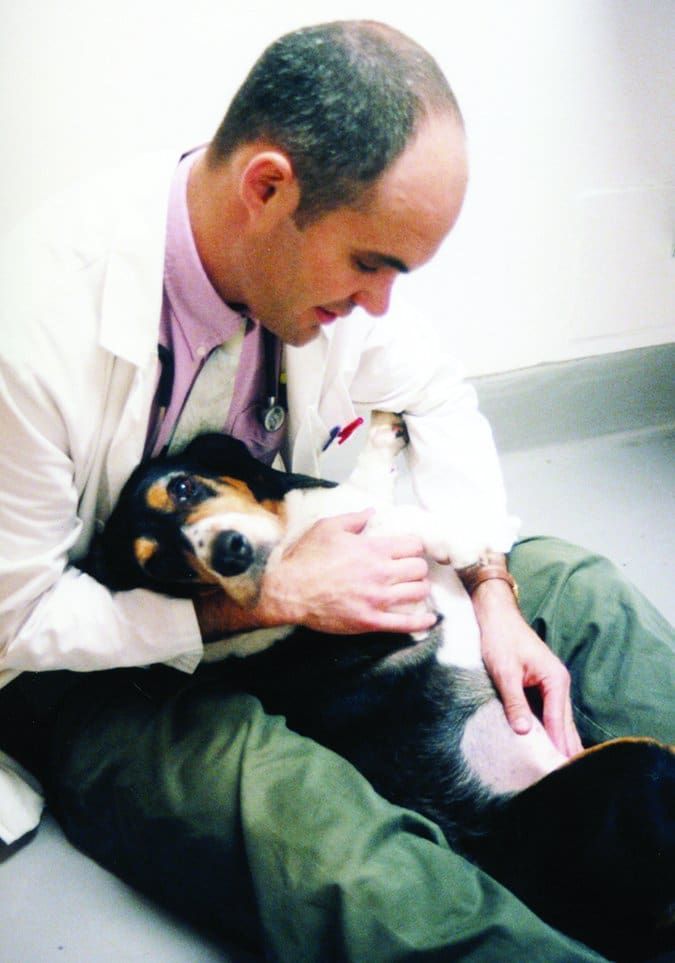When we talk about dogs, invariably we talk about dog people. The human desire to group things that interest us and build commonality among kindred spirits is hardwired- as is our tendency to segregate and highlight differences. As a result, dog people may identify as belonging to as many different canine communities as there are breeds. And within those “tribes,” we have mores, and values, and politics – and not all of them are compatible.
I belong to a tribe that is somewhat beleaguered these days: I breed and show purebred dogs. I screen my homes carefully. I have long legal contracts that require any dog of my breeding to be returned to me if he or she is no longer wanted, regardless of reason or age or health condition. And, of course, I require that all puppies that I sell as companions be spayed and neutered.
But in recent years, my attitude on that last score has begun to change, in large part due to new information about the potential for adverse effects of spay and neuter surgeries. My contracts still require those lovely and loved companions to be altered, and in more than a decade I have never had any reproduce (at least as far as I know!). But the details regarding when I want spay/neuter surgery done on my puppies have changed, and likely will continue to evolve.

Broaching the subject of delayed spay/neuter – and in the case of some males, perhaps not neutering at all – is the doggie equivalent of discussing Clinton versus Trump at the Christmas dinner table, which gives me pause, because I let that happen last month, with predictably disastrous results. It has the potential of making people angry, threatened, bewildered, regretful – maybe even a combination of all those. That’s not my intent.
What I want to do, though, is open up dialogue on a subject that for a long time has been presented as black and white.
While no one questions the importance of spay/neuter as a tool to stem animal overpopulation, the questions on the table are: Does one size fit all? Should committed, responsible people review the facts and scientific literature to make an individualized decision for their particular dog? Is it always necessary to remove testes in a male dog and ovaries in a female dog in order to render them sterile, or are there other options? What are the real risks of keeping a dog intact for some period of time, balanced against a growing body of evidence showing that early spay/neuter might be implicated in a number of orthopedic, oncological, and even behavioral problems?
So many questions, and unfortunately, no clear-cut answers.
A Spay/NeuterHistory Lesson
The American embrace of spay/neuter evolved in concert with human population trends. The post-World War II “baby boom” and economic expansion saw families increasingly bringing dogs and cats into their households – and the animals reproduced even more prolifically than the families themselves.
As cities (and later, rural communities) began to employ and then depend on animal shelters to deal with stray and unwanted pets, the population of animals concentrated in those facilities, leading to routine killing of excess dogs and cats. Spay/neuter was embraced enthusiastically by shelter workers and rescue volunteers alike as an effective tool for helping control the population of unwanted animals and reducing euthanasia. By the 1970s, the veterinary culture had also embraced surgical sterilization for population control.
This is in contrast to attitudes elsewhere in the world, particularly in many parts of Europe, where unaltered dogs are common. In Norway, it is illegal to spay or neuter a dog without a valid medical reason. The rationale is that it is morally wrong to surgically alter a dog for human whim or convenience, which puts spay/neuter on a par with ear cropping and tail docking.
Over the decades, as animal sheltering has increased in visibility and animal rescue has become more popular, spay/neuter has hardened into an almost militant social policy. Today, it’s widely a cultural norm for dogs to lack any physical signs of sexual maturation. I’ve had puppy buyers balk at the idea of a female’s silhouette being made “unsightly” by visible nipples, and I had a co-worker who almost threw up at the idea of testicles on a male dog. “Rubbing on my couch – ugh!” she proclaimed.
And, oftentimes, what we don’t know, we fear. “The average person has never seen a dog in heat, never seen dogs mating, never watched a female give birth, never watched her raise her puppies,” one veterinarian reminded me.
Spay/Neuter from a Medical Perspective
Population control – specifically, as a tool to reduce the mass killing in our nation’s animal shelters – has always been the overarching goal of spay/neuter campaigns. Other benefits of sterilization surgery have been enthusiastically promoted by veterinarians and the shelter community alike.
For example, spaying prevents pyometra, which affects a full quarter of all intact females by age 10. And in males, neutering removes the possibility of testicular cancer as well as reduces the risk of prostate enlargement and infection later in life. Neutering is also believed to reduce hormone-related behaviors such as leg lifting, humping, and male-on-male aggression.
The universal recommendation that dogs and cats of both genders undergo sterilization surgery at six months of age came from the handy benchmark of the average age that most females come into heat. Those involved in animal sheltering have been the most vocal proponents of even earlier sterilization, now commonly referred to as pediatric spay/neuter. Shelter medicine experts point out that pediatric spay/neuter surgical procedures are easier and faster; and with shorter surgery and anesthesia times, the incidence of postoperative complications is low, and recovery very quick.

Prior to widespread acceptance of this practice, shelters often allowed adoption of intact pets, and held a deposit from pet adopters, returning the money only when the owner showed proof that the pet had been sterilized. However, some owners failed to comply, giving up the deposits, and others complied only after the pet had an accidental litter. Pediatric surgery closed this loophole; indisputably, the biggest benefit of pediatric spay/neuter is populational. With this tool, shelters can prevent every animal leaving the shelter from ever reproducing.
Shelter workers and veterinarians who offer pediatric spay/neuter are understandably fans of the practice, citing those quick recovery times for young animals. The biggest long-term health benefit of pediatric sterilization, however, is usually identified as the prevention of mammary cancer in females.
Questioning the Spay/Neuter Status Quo
As with a number of other canine healthcare practices, in recent years, the conventions of spay/neuter surgery are being questioned by some canine health experts and dogs owners – particularly those with a “holistic dog” mind set, many of whom are accustomed to questioning the status quo.
Most of these owners also research what is in their dogs’ food and their veterinarians’ vaccine syringes; they want to do what’s healthiest, what’s most natural, for their dogs, even if it challenges – or upends – the conventional wisdom. But this topic could be the third rail of dogdom: the assumption that we should automatically and unquestionably spay and neuter all our companion dogs.
Some of these owners, influenced by the opinions of a few canine health experts, are beginning to question the validity of many long-held beliefs about the medical and behavioral benefits of spay/neuter. A growing number (particularly those in performance eventing, who are closely attuned to changes and weaknesses in their dogs’ bodies) are contemplating delayed spay/neuter, and – increasingly, in the case of males – even dispensing with it altogether.
One of the most vocal opponents to today’s spay/neuter conventions is Chris Zink, DVM, PhD, DACVP, DACVSMR, of Ellicott City, Maryland. Dr. Zink’s interest in the subject was promoted by her work with performance dogs, who compete in high-impact, physically demanding sports like agility. Many, if not most, of these dogs are sterilized.
In 2005, Dr. Zink first published an article, “Early Spay-Neuter Considerations for the Canine Athlete,” which lists studies that highlight the risks of early spay/neuter. One orthopedic issue she mentions (and one that I have seen time and again) is the elongated “look” that results from prematurely shutting off the sex hormones that govern the closing of the growth plates. These longer, lighter limbs, and narrow chests and skulls aren’t just a cosmetic concern: A 2002 study published in Cancer Epidemiology, Biomarkers & Prevention showed that this lengthening of the long bones creates a significantly higher risk of osteosarcoma, or bone cancer, in dogs altered at younger than one year.
The list of problems that Dr. Zink associates with early spay/neuter continues: greater risk of hemangiosarcoma, mast cell cancer, lymphoma, and bladder cancer; higher incidence of hip dysplasia in dogs spayed or neutered at six months of age; significantly higher prevalence of cranial cruciate ligament (CCL) injury; heightened risk of urinary incontinence in females that are spayed early, as well as some cases in males; greater likelihood of hypothyroidism in spayed and neutered dogs; higher incidence of infectious diseases in dogs spayed and neutered at 24 weeks or less; higher incidence of adverse reactions to vaccines in altered dogs; and increased risk of prostate cancer in neutered males.
It’s a long list, and it grows as Dr. Zink adds other studies that support the view that on balance, early spay/neuter is “not more healthy” than waiting until a dog is sexually mature before he or she is altered.
Health is not the only area where Dr. Zink questions the benefits of early spay/neuter; she is currently co-authoring a study that analyzes how spay/neuter affected 26 different behavioral components in 15,000 dogs. “The fact of the matter is, spay or neuter doesn’t improve their behavior in any way,” she says. “[Intact dogs] are not more aggressive to dogs or strangers.”
To say Dr. Zink’s position on the importance of avoiding early spay/neuter is controversial is perhaps an understatement; it does, after all, contradict the position held by most general-practice veterinarians. Critiques and rebuttals to each of her bullet points are all over the Internet; one person who read an early draft of this article called her a “zealot.” And for every study she cites, a Google search will undoubtedly turn up another that says the opposite.
But to me, that just reinforces the importance of keeping an open mind: With so many differing viewpoints, how do we know who is right? “It doesn’t matter if we all don’t do the ‘right’ thing,” goes one of my favorite lines about following the lemmings when you breed dogs. “It just matters that we don’t all do the same thing.” I think that applies to early spay/neuter, too.
My Personal Approach
When I changed my attitudes about annual vaccination and about feeding raw versus kibble, it was easy to get caught up in the battle of facts and statistics that both sides drummed up. In the end, the tool I used to make my decisions about “what is best” for my dogs was common sense. I stepped back and asked: Does it make sense to feed a dog a diet of processed foods whose protein sources are not fit for human consumption? Does it make sense to overload a dog’s immune system with yearly vaccines for some diseases that are not prevalent or ultimately life-threatening?
And for early spay/neuter, I asked myself: Does it make sense to think that you can remove a puppy’s major reproductive organs – and all the hormones that go with it – and not expect there to be some biological ramifications? For me, what has been missing from the spay/neuter discussion has been the question of holism, which can’t be answered by citing JAVMA papers or orchestrating double-blind studies.
Myrna Milani, DVM, of TippingPoint Animal Behavior Consulting Services in Charlestown, New Hampshire, thinks back to the zeal with which she approached spay/neuter during the 1970s. “I could have won the Golden Gonad Award – there wasn’t a pair of testicles or ovaries that was safe from me,” she says. “Then I woke up one day and thought, ‘My God, what have I done?’ As a woman who went through puberty, who menstruated, who had sex, who had children, who was going through menopause, how in the world could I have been so naïve as to say that all ovaries did was affect reproduction? That they did not affect the entire body?
“Dogs are like us: We have testosterone and estrogen receptors all over our bodies – they are in our brains, lungs, bones . . . They affect learning, they affect memory,” Dr. Milani says. If we remove the organs that produce most of the body’s testosterone and estrogen before those hormones have an opportunity to exert their influence on the dog, we’re going to have to deal with the consequences down the road, she warns.
Risks and Solutions: Spaying Females
The two biggest health benefits cited for spaying females before their first heat is reduced risk of mammary-cancer rates and the elimination of pyometra. Personally, unless a female is being used for breeding, I can’t find a justification for keeping her unspayed indefinitely. For me, the question is not whether to spay, but when to.
In terms of my own puppy buyers, I have encouraged them to allow their female puppies to go through one heat cycle before spaying – provided they know what they are getting into (see “Keeping Intact Dogs“) and can house a female pup securely for that three-week period. Though there are no studies to confirm this, anecdotal evidence suggests that allowing the body to go through a heat allows the genitalia to mature normally, avoiding or resolving inverted vulvas that can lead to incontinence. It also permits the maturation of estrogen receptors, which might also play a role in incontinence, a known risk of spay surgery, and beyond.
A study published in the Journal of the National Institutes of Cancer in 1969, “Factors Influencing Canine Mammary Cancer Development and Post-Surgical Survival Rates,” is the most commonly cited reference regarding the correlation between spaying and mammary cancer in dogs. It says that females spayed before their first heat have an almost zero chance of developing mammary cancer; after the first heat, that risk rises to 8 percent, and 26 percent after the second heat. Beyond that point, the study says, the protective aspect of spaying (as regards mammary cancer) is negligible.
Though that study is almost universally quoted when supporting early spay, it’s also been criticized as poorly designed. Even so, I always thought that an 8 percent increased risk of mammary cancer was a chance was worth taking, if allowing the dog to mature sexually helped prevent other issues such as other cancers and various orthopedic concerns. Mammary cancer isn’t the only thing female dogs can die from; it is one concern among many.
Since our experience colors things, my attitude also likely has to do with the fact that I have not had much experience with mammary cancer in my intact females or those of fellow breeders. That is not to say that it won’t happen – and as soon as you say, “Not me!” it usually does – but for the moment, cancers like lymphoma and hemangiosarcoma are anecdotally more prevalent, even among the retired breeding bitches I know.
Both Dr. Zink and Dr. Milani think that in the case of females, spaying after the second heat (which is likely to be more regular and normal than the first heat) is ideal. Milani points to a 1991 study in the American Journal of Epidemiology that showed that the risk of mammary cancer was significantly reduced in females who were spayed at or before 2½ years old, and who had been thin at nine to 12 months of age.
When it comes time to do the spay surgery at whatever age, Dr. Zink advocates removing just the uterus and leaving the ovaries intact. In this way, there is no risk of pyometra, the female will not go into heat and be attractive to males, she cannot get pregnant – and she retains her hormone-producing ovaries. She cautions, however, that the veterinarian performing the surgery needs to be sure that the entire uterus is removed, because dogs can develop stump pyometras, which are just as life-threatening.
While performing a tubal ligation, or “tube tying,” is certainly an option, it is somewhat impractical, as removal of the uterus at a later date still would be necessary to eliminate the risk of pyometra.
What are the proven risks or benefits of removing a dog’s uterus but leaving the ovaries intact? No one can say for sure; it simply has not been done enough. Would those hormone-producing ovaries continue to raise the risk for mammary cancer? Or, conversely, being unable to “communicate” with the uterus that they know is supposed to be there, would the ovaries eventually stop working, as they do with women after hysterectomies? Again, no one knows for sure.
Alternative Solutions: Neutering Males
In many respects, delaying neutering in males is a little easier: The health ramifications, while still present, are not as dire as for females.
Testicular cancer is still a concern, but is easily detectable, Dr. Zink says. “You just watch for it by examining the testicles regularly. If you see one testicle is larger, it usually means there’s a tumor there, but it is almost always benign. However, at that point you would have the testicles removed.”
A bigger problem, in my experience, is prostatitis in intact males, especially older ones who are sexually stimulated by intact females in the household. If a prostate infection develops, and leads to an abscess, it can be difficult to diagnose. I almost lost an unneutered older male to an abscess that had thankfully not yet gone into sepsis -but I have friends with dogs who were not as lucky.
Because of health considerations, my puppy contracts currently ask that male puppies not be neutered before 12 months, and ideally at 18 months. Some people are willing to wait, but most aren’t, and that’s okay with me; I tell them to hang on for as long as they can.
However, if their male dog will be taken to visit dog parks on a regular basis, then I tell them to neuter before he really begins to elicit a response from the neutered adult males there – usually by 10 months of age. If not, one day when his hormonal signature becomes a threat, the neutered dogs will go for him (though he will be blamed, because he is the intact one), and his happy-go-lucky attitude toward other dogs might change forever. And that’s just not worth an extra couple of months of testosterone in my book.
The people who have my males are responsible caretakers who don’t permit them to roam and who don’t have unspayed females in the household. Frankly, I’m okay with ultra-responsible people leaving these males dogs intact as Mother Nature made them, for life. But for males who are at risk of being inadvertently bred – or whose breeders require in their contracts that they be sterilized – Dr. Zink recommends vasectomy. This renders the male unable to reproduce, but allows him to continue to produce testosterone.
While a male with a vasectomy won’t be able to sire puppies, he likely will have difficulty fitting into some social situations, such as dog parks. A vasectomized dog still has his testicles and appears to be entire, and “lots of dog parks won’t let you bring a dog in if it is intact,” warns Dr. Zink. And because such dogs still produce testosterone, “and neutered dogs tend to be aggressive toward intact dogs” (not, as many believe, the other way around) the snipped males at the run will be just as snarky, because their noses will alert them to a vasectomized dog’s unchanged testosterone levels.
As for dogs with retained testicles, “a study has been done that showed for every 100 dogs with retained testicles who live to be 10, 12 of them will get cancer of the testicle, though it is almost always benign,” Dr. Zink says. Because this does not happen until the dog is older – around age seven or later – she recommends keeping dogs with retained testicles intact until they are three or four, then removing the retained testicle and vasectomizing the other.
Obstacles and Social Acceptance of Keeping Intact Dogs
Of course, most shelters and rescues require spay/neuter surgery on every dog they place, and adopters are rarely permitted to dictate the timing of the surgery (though, presumably, most never ask). For many who rescue and rehome dogs, this entire discussion is moot; they are understandably more committed to saving unwanted dogs’ lives than optimizing the lives of dogs obtained at puppyhood from a breeder.
Among my fellow breeders, the idea of delaying spay/neuter is no longer a hot button. Not everyone does it, but pretty much everyone respects your right to take a different approach – as long as the owners are responsible, and capable of preventing their animals from accidental breedings and of providing the scrupulous medical care and attention needed to detect signs of health problems, such as mammary or testicular cancer, that can occur in intact dogs and those who were sterilized later in life.
And that brings us to the uncomfortable realization that spay/neuter also has much to do with issues of socio-economics and class. Cultural attitudes, knowledge base and lifestyle can vary dramatically, depending on where you live. That isn’t to say that one category of owner is “better” than the other, just that they are different, and they come with different risk levels. Many rescuers or breeders feel their adopters or puppy people can’t handle the very serious responsibility of deferring spay/neuter to a later date. Still others see the subject as a Pandora’s box: If social attitudes soften and spay/neuter loses its sense of urgency, could it set back all the hard work done by committed rescuers?
Cultural attitudes aside, there is a pragmatic problem to taking an alternative approach to spay/neuter, such as removing only the female’s uterus or performing a vasectomy on a male dog: many vets are not open to it. Author, blogger, and veterinarian Patty Khuly, of Sunset Animal Clinic in Miami, Florida, says she gets a few emails a week asking for help in finding a vet capable of and willing to perform the alternative procedures. Dr. Khuly responds by advising the emailers how to talk to their vets. “I tell them to explain that [the procedures] are described in surgery textbooks. Be thoughtful about why you want it done. Say, ‘I know you think this is weird, but I have thought about it quite a bit. There are vets doing it across country, though there are not many of them. I’ve been told it’s easier to do than a [conventional] spay/neuter.’ The vet might be curious enough to attempt it.”
While conventional spay/neuter practices and schedules will likely be the norm for the foreseeable future, as with every other important decision that you must make about your dog’s care and feeding, it’s important to inform yourself about the advantages and disadvantages of early, adult, or no spay/neuter surgery – and then make a decision that is right for you and your individual dog. Once that choice is made – no matter what choice it is – take responsibility for the consequences.
Denise Flaim of Revodana Ridgebacks in Long Island, New York, shares her home with three intact Ridgebacks, three 8-year-old children, and a very patient husband.







I found it interesting that you state that getting your dog spayed or neutered can help prevent cancer in those areas. My wife and I are getting a puppy for our daughter’s birthday and want to make sure we are taking care of it right. I will keep this in mind and look for an animal hospital that can help us out.
Just to clarify, dogs who have their uterus removed and keep their ovaries, still go into heat and are still attractive to male dogs. The difference is that they don’t bleed. Both of my dogs have the ovary sparing spay and I have to watch them more closely for 3 weeks/2x per year. It’s not a difficult price to pay for better health. One of my dogs has a false pregnancy after every heat (collecting stuffed animals and nesting).
It would be great to have sources! I’d be interesting in reading that 1991 article Zink and Milani quote.
We are still on the fence about spaying our 4 year old female. She’s never had any health issues and hasn’t been pregnant. At one point we considered breeding her and now we’re probably not going to bred her but don’t feel any real need to spay her because we worry it could change her or cause health problems.
After working in rescue and coming across multiple females with pyometra (several fatal) I would always spay.
I recently adopted a 4 mo old puppy from the local animal shelter and he was neutered the day before I got him. His legs and torso is growing very long (I’ve had him for about a month) and he supposedly a spaniel mix. But now I’m thinking it’s because he was neutered too soon. I’m saddened by this.
My dad can longer take care of one more puppy, which is why he’s planning to have his DOg Trixie spayed. Well, thank you for clarifying here that the risk of neutering will depend on the dog’s breed, age, size, and health status. Although, I also agree with you that spaying is beneficial in terms of controlling the population and reducing mass killing in our nation’s animal shelters.
Definitely wish we would have read this article before adopting our now 4.5 mo old shepherd lab mix. It is our 3rd rescue pup, we usually get them at appx 9-10 weeks, and have learned that it is the policy of nearly all rescues to spay them a day or 2 before they go home. We have had significant incontinence issues with this puppy. She is fully potty trained, and did so easily. She loses control of her bladder when she is asleep, or when she relaxes. It seems to be worse in the evenings, and she doesn’t seem to even feel that it is happening. She doesn’t squat to pee, it just falls out of her and drips while she walks. We are investigating medication and possibly surgery to help her. Had we known this was a more common problem, we would have asked them to let us hold off until first heat.